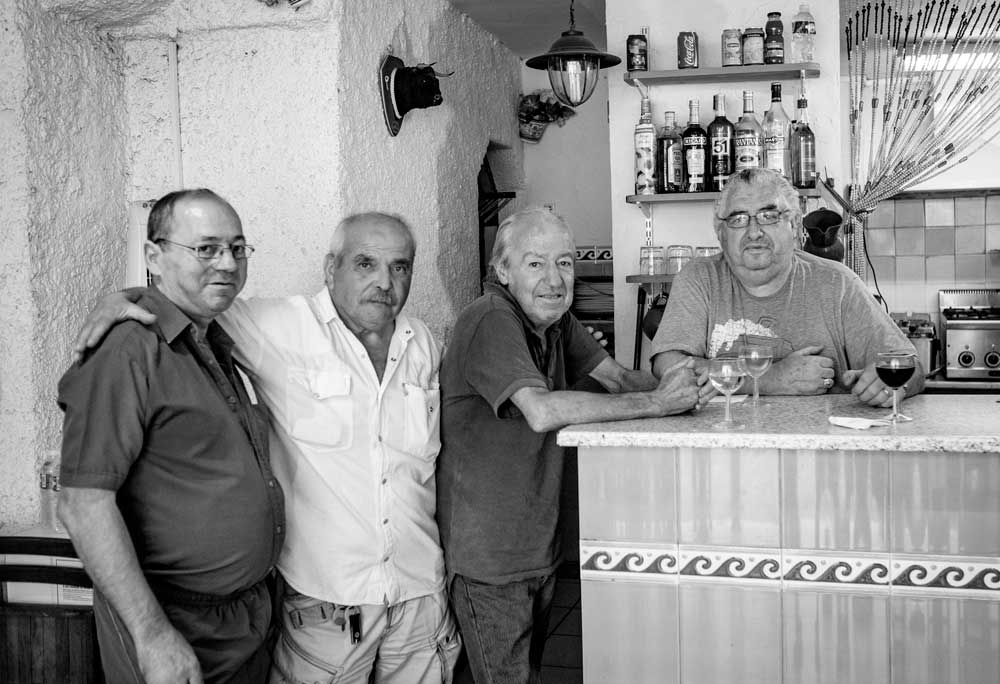Task 11 – Stronger together
Task 11
Stronger together

The camera is a contact-creating curiosity machine. It gives us a pretext for getting a foot inside the door and getting to know people and places we would have otherwise passed by. In Perpignan Jan wanted to photograph people even though he thought it was frightening to do so. He took even better pictures than this one but not ones that illustrated as well the concord between the regulars at the café that he chose to photograph. We can literally feel the beam of healthy oxytocin that radiates out of the men’s eyes and gives them a sense of well-being. Without a camera maybe he would have stopped for coffee and then passed by. Photography became the key to a rewarding encounter.
Perpignan, France, 2014. Photo: Jan von Krogh
Problem
Solitude
In hunter/gatherer societies, parts of the tribe gather together for all of the tasks. Prepa- ring food, hunting, housework and other activities are always done together with some- one. You are never alone. It is within such communities that our brains have emerged. We are wired for connection. In the present time, we spend a larger proportion of our days at home or in front of a screen at work. Spending time alone seems to give us a reduced sense of well-being perhaps due to a lack of oxytocin and the situation is made worse when a feeling of discomfort creates a need for being isolated. An evil circle begins: depression hinders human contact and a lack of contact re-inforces depression. I meet many such patients that spend every day alone.
Being lonely produces a chronic feeling of stress in the body, it hinders the immune system to do its most important job. The extreme stress and discomfort are caused by the old part of our brains assessing the state as being an acute threat to us. Being in isolation and ostracized from the tribe was more dangerous than snakes, spiders and lions for our ancestors.
Even if the new part of the brain understands that there is no way we are going to die, this knowledge is of no use to the old brain. If we get too little oxytocin, which is the hormone that separates us from reptiles and keeps us mammals together, the old brain will interpret it as life threatening. In that case the stress hormone cortisol has the upper hand.
In his book A Philosophy of Loneliness, Lars Svendsen writes about common traits among people who are lonely: ”They are less trusting of others and more critical than other people are towards themselves and their surroundings. They are social perfectionists. It takes less for them to feel like a situation is untenable. Lonely people are the most negative towards other lonely people. Chronic solitude has a lasting corresponding condition of pain that is equivalent to the loss of 10 to 15 years of life.”
I recognize his description in the many lonely patients I meet. It may well be that their crit- ical manner has caused their loneliness, but it could also be that the solitude has led to their hostile attitude towards life. Regardless of the cause, it doesn’t help them when they try to seek out the company of other people.
In The Camera Cure® I encourage you to take pictures of the people who are closest to you and your work colleagues, and to discuss the photos together with other people. This can be a way of breaking out of this evil circle. Being together in itself is good for our health.
Do you know someone that could have ended up alone because of these reasons?
On a scale of 1 to 6, how relevant is this issue for you?
Solution
Being together
Even though photography is an individual activity, it offers good possibilities for getting out of being lonely. We were created for feeling connected to others and the camera can help us do that. Photography offers a pretext for making contact with and meeting people.
We get a rush of oxytocin when we are together with people whether it is at a concert or a beach. We were made for being together. We are stronger then. And in order to achieve this, our nervous system has a built-in reward system. We get filled with oxytocin when we socialise. Where this was previously necessary for survival, today it is vital for our well-being. When the audience at a rock concert is jumping together in rhythm, hormones flood in and provide them with tangible well-being that is demonstrable for days afterwards.
In our everyday lives as well, at work or when we visit friends, we get certain doses of oxy- tocin. Photographers who gather together in clubs or on courses get loads of oxytocin.
One of the most important effects of being together with others is that it deprives us of the possibility of ruminating on heavy thoughts at the same time.
We should be careful about who we spend time with. We are strongly affected by the people we are around. If we regularly meet others who complain about their state of affairs, it is easy to be infected by it. People are good at mirroring others and if you meet an irritable person you will subconsciously begin to mirror their speech, facial expressions and body lan- guage. Irritable people will experience that the world is irritable in return.
If you are timid, sad and isolated, then be with people who are outgoing, happy and generous. Their vitality will be contagious!
Photo assignment:
Here you can choose to photograph people enjoying each others company, or maybe the opposite? Contact a friend of family who feels lonely and try to convey the feeling of loneliness. Maybe you can lighten up their day.
How useful was this task for you on a scale of 1 to 6?
BOOK SUGGESTION: How To Win Friends by Dale Carnegie
❞ Choose people
who lift you up. Find people who will make you better.
Michele Obama
❞ Is there a more exciting adventure than to meet new people and find out what is inside of them?
Sonja Henie
❞
A friend is one that knows you as you are, understands where you have been, accepts what you have become, and still, gently allows you to grow.
William Shakespeare
[note_editor]

